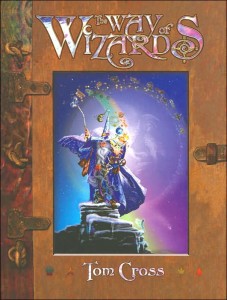 Undoubtedly inspired by the wave of wizardphilia that’s swept the world ever since Harry Potter hit that magical zeitgeist switch, The Way of Wizards is a full-color coffee table art book in the same tradition as Brian Froud’s Faeries, except that this goes into the world and ways and mysteries of the wizards.
Undoubtedly inspired by the wave of wizardphilia that’s swept the world ever since Harry Potter hit that magical zeitgeist switch, The Way of Wizards is a full-color coffee table art book in the same tradition as Brian Froud’s Faeries, except that this goes into the world and ways and mysteries of the wizards.
It’s both written and fully illustrated by Tom Cross, who describes his style of blending techniques and inspirations into his artwork as “nature folklore.”
It starts out with a chapter on defining wizards: their origins, the source of their power, and their rhyme and reason. Like many of these books, it’s written in a scholarly fashion, as if initiating a new apprentice or wizard into their world. It takes us on a journey of the Wizard’s Council, the Hall of Beards, the Cave of Names, the University of Wizardry itself. There’s a look at a wizard’s tower, and the reason they like to live in such strange places. Thus might you look for -and find- wizards, if you know where to seek them.
It goes into more detail, then, showing us how the wizards might divide themselves, so that four of them — the most powerful — each oversee an element: Earth, Air, Fire, Water, and how they relate to the appropriate colors for each element. There’s Star Weaver, the wizard of Air, and the fairies he watches over as part of his role. There’s Wind Sifter, wizard of Earth, who likewise has dominion over the various races of elves, and all the green things of nature. Flame Catcher is the wizard of Fire, and his people are the many dwarves and under-dwellers. Finally, there’s Shell Caster, wizard of Water, and guardian of the merfolk.
A chapter devotes itself to tools of the trade, explaining such things as wands, pointy hats, amulets, staves, even the robes. Who’d ever have guessed that a wizard’s pointy hat acts as a lightning rod for magic?
Then we have information on the gatherings and societies of wizards. The book covers places such as the mighty University of Magic, the School of Tutelage and the Academy of Instruction, where apprentices go to learn all they must before they can become wizards in their own right. There’s also the College of Supernatural Knowledge, and the Institute of Wizdom, which each has a role to fulfill.
And more: wizard holidays, communing with nature and animals, trapping magic, affecting weather, the uses for flowers and metals and jewels. Wizards who go to war and do battle magically. Magic in all its forms.
The true strength of this book is definitely the artwork. Cross’ style is very evocative, fully painted and bursting with color and life on every page.
He creates this whole world from scratch, and populates it with wizards and creatures of all descriptions, lovingly detailing dozens of fairies and elves and mythical beasts. He captures the essence of magical items, and details every stone in their towers with the same precision. As artistic endeavors go, this is truly a sight to behold.
Comparatively, I found the text to be a bit silly, and hard to believe in, especially with the names (as above, the various elemental wizards). I had trouble taking it all seriously enough to let myself fall into the world created. A younger audience will undoubtedly love it, and be absolutely enthralled with the bright, lively artwork. However, don’t go in to this thinking it’ll be a serious or terribly adult read. Embrace your inner child first, if you want to look at this book properly.
All in all, I find The Way of Wizards to be absolutely beautiful in terms of the illustrations, but a bit lacking where the text is concerned. Certainly it’s quite thorough, drawing upon a wealth of legend and lore and creating something new, but it doesn’t ring like some books do. At a hefty $34.95 retail, you’ll want to look through it for yourself before committing.
